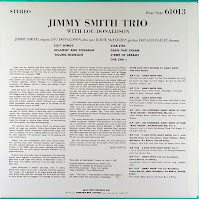Jimmy Smith Trio + LD
Released - February 21,1985
Recording and Session Information
Manhattan Towers, NYC, July 4, 1957
Lou Donaldson, alto sax #3-7; Jimmy Smith, organ; Eddie McFadden, guitar; Donald Bailey, drums.
tk.4 Cha Cha J.
tk.5 'Round Midnight
tk.6 Street Of Dreams
tk.7 Star Eyes
tk.8 Darn That Dream
tk.9 Soft Winds
tk.14 Hollerin' And Screamin'
Track Listing
| Side One | ||
| Title | Author | Recording Date |
| Soft Winds | Benny Goodman | July 4 1957 |
| Hollerin' And Screamin' | Jimmy Smith | July 4 1957 |
| Round Midnight | Thelonious Monk | July 4 1957 |
| Side Two | ||
| Star Eyes | Raye-De Paul | July 4 1957 |
| Darn That Dream | De Lange-Van Heusen | July 4 1957 |
| Street Of Dreams | Lewis-Young | July 4 1957 |
| Cha Cha J | Jimmy Smith | July 4 1957 |
Liner Notes
Those who are familiar with Blue Note listing know the story of Jimmy Smith's coming to the label. Babs Gonzales was his first manager and the man who set up the meeting with Alfred Lion in January, 1956.
It was not so much an audition as it was a public performance. Smith was playing his first New York engagement at a Harlem nightclub, Small's Paradise. It is instructive to remember this because Harlem is where the interest in jazz organ really took root.
Wild Bill Davis was the first major organ soloist. He was followed by three players with similar roots: Milt Buckner, Bill Doggett and Sir Charles Thompson. All three were leaders and arrangers and fine, individual pianists. There were others who didn't record but who worked the clubs and lounges along the Eastern seaboard. Cootie Williams was a popular Black bandleader who was using organ in his groups (at the Savoy Ballroom) as early as 1949.
The opportunity to hear these players around Philadelphia was easy for Smith. Many of them had roots in Philadelphia (which also developed Jackie Davis, Shirley Scott, Jimmy McGriff and Charles Earland), and there were several clubs in Philadelphia that featured organ combos. At the time Smith made the change to playing organ himself, he was working with Don Gardner, the singer and bandleader.
The qualities that made Jimmy Smith the second major soloist on organ are twofold. Unlike Davis, whose style was heavily chordal, Smith emphasized lightning-fast single note lines. In addition, his firm, walking basslines were the envy of all other organists. This particular aspect of his playing was truly revolutionary.
Alfred Lion was immediately taken with Jimmy Smith. His working trios were recorded quickly and frequently. The jam sessions followed, as did his sessions with singers. Finally, in the 1960s, came the classic meetings with Stanley Turrentine. But this early period obviously included a lot of experimentation.
Exactly how and under what circumstances this particular session came together is conjecture, but the chances are very good that it was night time session at Manhattan Towers in New York. Van Gelder preferred to do late night sessions in New York.
Eddie McFadden is seldom discussed, even in Jimmy Smith liner notes, but he was a splendid rhythmic guitarist. The "comp" of a guitarist in an organ group was different with Smith than what Bill Jennings did with Wild Bill Davis or Billy Butler did for Doggett. The strength of Smith's bass offset the need for a straight rhythm approach and the offbeat fills and riffs set by McFadden (and his predecessor Thornell Schwartz) created a style that youngsters such as George Benson and Pat Martino would further refine in the 1960s. McFadden is a fine soloist as well. Hear any of his spots here.
Donald Bailey settled in California in the middle 1960s and wickly became one of the top percussionists in Los Angeles. Jimmy Smith had drummers before and after Bailey, but rarely did he find one with Bailey's intelligence and swing. There is a certain discipline to playing with an organ group. If you get too loud or too busy, you ruin the groove. Listen sometime to Elvin Jones play with Larry Young and Grant Green. He plays quite differently than he did with John Coltrane.
Lou Donaldson had worked with Smith in the February 1957 sessions that produced Blue Note 1547, 1548, 1551 and 1552. Lou was a player who had much in common with Smith. Both men had deep blues roots in addition to their obvious affinity for modern jazz. They work beautifully together throughout this album. Perhaps the revived Blue Note label will reunite them!
The music offered here is typical fare for 1957 with a few notable exceptions. Hollerin' And Screamin' is the blues and has no connection with the Lockjaw Davis tune of the same name. Smith had recorded 'Round Midnight in 1956 with Gonzales singing (Babs and Smith had dissolved their business dealings a few months prior to this session. The Smith tune The Fight celebrates the split, but Smith was the firs to do Monk on organ. Cha Cha J is a bit unusual. It was issued on a 45, but not until more than a year later.
But this minutiae should not deter you from enjoying a master musician at the top of his game. Blue Note Jimmy Smith is the best Jimmy Smith.
-BOB PORTER



No comments:
Post a Comment